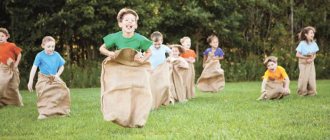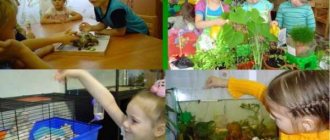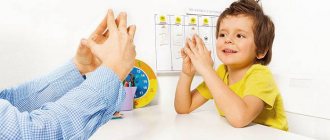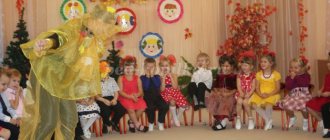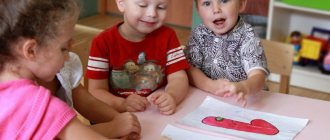MAGAZINE Preschooler.RF
Krivosheeva Irina Vladimirovna MADOU "Kindergarten of a combined type No. 15, village. Kabansk" A Chinese proverb says: “Tell me and I will forget, show me and I will remember, let me try and I will understand.” Everything is assimilated firmly and for a long time when the child hears, sees and does it himself. Life in all its manifestations is becoming more diverse and complex; The further it goes, the more it requires from a person not stereotyped, habitual actions, but mobility of thinking, quick orientation, and a creative approach to solving large and small problems. The preschool institution and parents are faced with a task of essential importance: to ensure that every child grows up not only as a conscious member of society, not only as a healthy and strong person, but also - without fail! - proactive, thoughtful, capable of a creative approach to any task.The path to becoming a creative personality is complex and difficult. But these great difficulties can also give great joys: the joy of overcoming, the joy of discovery, the joy of creativity. Any activity proceeds more effectively and produces high-quality results if the individual has strong motives, bright, deep, evoking a desire to act actively, with full dedication, to overcome life’s difficulties, unfavorable conditions, circumstances, and to persistently move towards the intended goal. One such activity is experimentation. In the works of many domestic teachers Poddyakov N.N. (Nikolai Nikolaevich) Usova A.P., E.L. Panko says that “children’s experimentation claims to be a leading activity during the period of preschool development,” and identifies the main feature of this cognitive activity: the child learns an object in the course of practical activities with it. The practical actions carried out by the child perform a cognitive, orientation and research function, creating conditions in which the content of a given object is revealed. N.N. Poddyakov identifies two main types of orientation-research (search) activity in preschool children. The first is characterized by the fact that activity in the process of activity comes entirely from the child himself. He acts as its full-fledged subject, independently building his activity: setting its goals, looking for ways and means to achieve them, etc. In this case, the child, in the activity of experimentation, satisfies his needs, his interests, his will. The second type of orientation-research (search) activity is organized by an adult, who identifies the essential elements of the situation and teaches the child a certain algorithm of actions. Thus, the child receives the results that were previously determined by the adult.
Children are explorers by nature. An unquenchable thirst for new experiences, curiosity, a constant desire to experiment, and independently seek new information about the world are traditionally considered as the most important features of children's behavior. Research and search activity is the natural state of a child: he is determined to discover the world, he wants to know it. To explore, discover, study means to take a step into the unknown, to get the opportunity to think, try, search, experiment, and most importantly, express yourself. In this regard, in order to study the conditions for organizing experimental activities of children in the older group, diagnostics were carried out using the “Choice of Activity” method by Lyudmila Nikolaevna Prokhorova. This technique explores the preferred type of activity and reveals the place of children's experimentation in children's preferences. The results showed that three groups of children can be distinguished according to the level of development of children's experimentation. The first group included 5 children, which is 20%. The cognitive attitude of preschoolers towards experimental activities is stable. They show initiative and creativity in solving problematic problems. They see the problem. They actively make assumptions. Consciously choose objects and materials for independent experimental activities in accordance with their qualities, properties, and purpose. In a dialogue with an adult, the course of the experimental activity is explained. They bring the matter to an end. They formulate in speech whether the result has been achieved or not. They draw conclusions. The second group includes 13 children—that’s 52%. In most cases, the child shows an active cognitive interest in experimental activities. Sees a problem sometimes with a little help from an adult, makes suggestions with a little help from others (peers or an adult). Takes an active part in planning experimental activities together with an adult. Prepares material for experimentation based on qualities and properties. Can formulate conclusions based on leading questions. And in the third group there are 7 children – that’s 28%. They rarely show cognitive interest in experimental activities. They can see the problem only with the help of an adult. Take part in planning experimental activities at the suggestion of an adult. With the help of an adult, prepare material for the experiment. They are not always able to formulate a conclusion; they need a hint from an adult or an example from their peers. Reasons for the low level of mastery of experimental activities by children of senior preschool age: 1. Cognitive interest is unstable; 2. Children do not always see the problem; 3. Inactive in putting forward ideas; 4. The desire for independence is not expressed; 5. Use evidence with the help of an adult. Researcher Pavlov I.P. considered observation to be one of the most important qualities of a researcher, without which it is impossible to make a single discovery. Observation is a very complex process and requires enormous concentration of attention, intellectual and volitional efforts. Experimental activities are closely related to different types of activities. One of which is labor. It may not be associated with experimentation, but there is no experimentation without performing labor actions. On the one hand, the presence of labor and observation skills in children creates favorable conditions for experimentation; on the other hand, experimentation, especially one that arouses great interest in the child, contributes to the development of observation and the formation of labor skills. Cognitive and research activities permeate all areas of children's life, including play. Play in exploration often develops into real creativity. In our work with children, we attach great importance to gaming technologies, using didactic games: “Answer quickly”, “When it happens”, “Body”, “Who can name the most objects”, “What grows where?” “Such games help familiarize children with natural phenomena. Verbal games: “What’s extra?”, “Good-bad”, “Finish the sentence”, etc. develop children’s attention, imagination, and increase knowledge about the world around them. Construction games with sand and water help solve many problematic situations, for example: why dry sand flows, but wet sand does not; where a grain will grow faster in the ground or sand; Which things do water benefit and which things harm? All these questions force children to think, compare and draw conclusions. Experimentation and speech development are very closely related. This can be clearly seen at all stages of the experiment - when formulating the goal, during the discussion of the methodology and progress of the experiment, when summing up the results and giving a verbal report of what was seen. It is necessary to note the two-way nature of these connections. The ability to clearly express one's thoughts (i.e., well-developed speech) facilitates the experiment, while the addition of knowledge contributes to the development of speech. Consequently, without the addition of knowledge, the development of speech would be reduced to simple manipulation of words. The connection between experimentation and the formation of elementary mathematical concepts does not require special proof. During experiments, there is a constant need to count, measure, compare, determine shape and size, and perform other operations. All this gives mathematical concepts real significance and contributes to their understanding. At the same time, mastery of mathematical operations facilitates experimentation. Experimentation is also associated with other types of activities - reading fiction, music and physical education. Children maintain interest in experiments if the result is visible immediately or after a short time. Experiments with living nature, as a rule, are mostly long-term and require a certain patience from preschoolers, as a result of which interest in such activities often fades and the purpose of experimentation is forgotten by children. Therefore, to develop interest in search and research activities, we use experiments and experiences with inanimate nature, introducing children to the properties of water, sand, earth, clay, air, etc. They are carried out both in classes and in free independent and joint activities with the teacher. Research provides an opportunity to find the answers to the questions “how?” and why?" One of the conditions for solving problems in experimental activities in kindergarten is the organization of a developmental environment. The object environment surrounds and influences the child from the first minutes of his life. The main requirements for the environment as a developmental tool are to ensure the development of active independent children's activities. However, in order for the subject material of the environment, which is given at the free disposal of children, to become a stimulus, a source of research and search activity of preschoolers, they must have developed a minimum of knowledge and methods of action on which the child could rely. In this regard, a mini-laboratory has been created, where conditions have been created for joint and independent experimentation and the development of children’s search activity. When setting up the experimentation corner, the following requirements were taken into account: • safety for the life and health of children; • sufficiency; • age characteristics of children • accessibility of location
The laboratory has a variety of equipment: • Various instruments: scales, magnifying glasses, magnets, microscopes, magnifying glasses; • A variety of vessels from various materials: glass, metal, plastic; • Natural materials: leaves, sand, clay, earth, seeds; • Nuts, paper clips, cogs, nails, wire; • Medical materials: pipettes, flasks, syringes, measuring spoons, cotton wool, bandages; • Waste material: plastic, pieces of fabric, leather, fur; • Flour, salt, soda, candles, lanterns; • Children's robes, aprons; • Schemes for conducting experiments; • Journal for recording results.
Gradually, with the help of parents, we replenish the “laboratory” with new materials for experiments, support the interest of children, allowing them to reproduce the experience again and confirm their ideas.
When organizing experimental activities with children, we use the following forms of work:
* educational activities; * conversations; * didactic and educational games and exercises; * role-playing games; * experiments and experiences; * use of multimedia, video slides; * photoshoot; * card index of experiments; * competitions, holidays and entertainment.
The implementation of the set tasks is fully possible only if there is close interaction between the kindergarten and the family. You see the forms of working with parents on the screen, one of which is a survey
Shapes:
• visualization; • group parent meetings; • “Open Days”; • involving parents in the preparation and holding of holidays, entertainment, and open events; • A section in the parent’s corner “Ask! We answer!”; • Card index “Experiments” • organization of thematic exhibitions of joint creativity with children; • Questionnaire.
Questionnaire for parents: 1. Is your child active in research? What? 2.What objects and materials does your child like to experiment with? 3. Does the child continue the experimentation started in kindergarten at home? If yes, how often? 4. Do you take part in your child’s experimental activities? If yes, which one? 5. If a child achieves any result from an experiment, does he share his discoveries with you?
This is the basis for the active introduction of children's experimentation into the practice of our work. We have developed the project "Children's experimentation - young researcher" Project "Children's experimentation - young researcher" Project forms: elementary search activities, experiments, experiments Means: search activities Type of project: Group Conditions: gradual complication - from simple to complex, organization of conditions for independent and educational activities, the use of problematic situations. Relevance: During preschool childhood, along with play activities, search and cognitive activity is of great importance in the development of a child’s personality, which we understand not only as the process of acquiring knowledge, skills and abilities, but, mainly, as the search and acquisition of knowledge independently by the child or under the tactful guidance of an adult, carried out in the process of interaction, cooperation, co-creation. The goal of our project: - To develop the cognitive abilities of children through experimental activities. Objectives: - Develop your own cognitive experience. — Arouse a desire for search activity. Support methods: Exploratory observations and experiments: random observations and experiments, planned observations and experiments. Conducting experiments (practical). Conversations (constructive). Preparatory stage: Preparation of material for children's activities Selection of children's and scientific literature.
The main form of children's experimental activity, which we actively use, is experiments. We conduct them both in classes and in joint activities with children in special moments. When introducing children to objects of inanimate nature, we developed a long-term plan, which we divided into seven blocks: 1. Stones. 2. Soil. 3. Sand, clay. 4. Water. 5. Air. 6. Paper 7. The World of Fabric A number of classes were held to introduce stones. One of which is the educational “Amazing Stones”, where children remembered the plot of Bazhov’s fairy tale “The Malachite Box”, watched a slide show about the location of the stones, and conducted experiments. At home, together with my parents, I made various crafts from stones. In the “Soil” block, we looked at the soil through a magnifying glass, talked about how it affects plant growth, and in the group organized a mini-garden where we observed the growth of plants. In the block “Sand, clay” - looking at them through a magnifying glass, we discovered that the sand consists of small crystals - grains of sand, this explains the property of dry sand - flowability. And wet clay has properties - viscosity. When familiarizing themselves with the following blocks “Water”, experiments were carried out: “Pour in - pour out”, “Let’s paint over the water”, “Transforming water into ice”, “Sinking - doesn’t sink”, etc. All children take an active part in the process of conducting experiments. It was discovered that water is a liquid, has no odor, color, shape, and can freeze. These experiments somehow remind the children of magic tricks, they are unusual, and most importantly, the children do everything themselves. Thus, we develop in children curiosity, observation, the ability to communicate and find ways to solve problem situations. Expected result of our project: Thus, familiarizing preschoolers with the phenomena of inanimate nature occupies a special place in the system of diverse knowledge about the environment. By including it in the process of searching for the cause of a particular physical phenomenon, we create the prerequisites for the formation of new practical and mental actions in them. The result of the implementation of the project “Children's experimentation - young researcher” is the experience acquired by children of seeing objects and phenomena, peering into them, developing attention, visual and auditory sensitivity, expanding vocabulary and enriching speech communication based on cultural norms.
“The more a child has seen, heard, experienced, the more elements of reality he has in his experience, the more significant and productive, other things being equal, his creative activity will be” L.S. Vygotsky
| Next > |
Organization of educational and research activities with children of primary preschool age
Bibliographic description:
Voronkova, N.V. Organization of cognitive and research activities with children of primary preschool age / N.V. Voronkova, T.I. Silina. — Text: direct // Questions of preschool pedagogy. - 2022. - No. 10 (27). — P. 6-8. — URL: https://moluch.ru/th/1/archive/145/4696/ (access date: 01/29/2022).
The sooner we begin to instill in children the desire to achieve their own goals, the sooner we will create strong, and therefore independent and free people.
M. Montessori
Preschool age is the most important period in the development of a person’s personality. In accordance with the requirements of the Federal State Educational Standard for Education, each educational institution is faced with the task of creating conditions for the development in preschoolers of the ability to obtain knowledge from sources, to think independently and creatively. The main tasks that the Federal State Educational Standard will help solve are the creation of favorable conditions for the development of children in accordance with their age and individual characteristics and inclinations, the development of the abilities and creative potential of each child as a subject of relationships with himself, other children, adults and the world. The subject-spatial developmental environment is formed taking into account the characteristics of the basic level of the general education system; the age of the children and the need to implement educational tasks are also taken into account.
Each child is unique, has unique individual traits and characteristics, interests and abilities. To achieve good results in raising children, it is important to know and take this into account. The teacher needs to constantly monitor the activities of children and promptly notice changes in their development. Children are explorers by nature. They are interested in everything, their attention is always directed to what is interesting. And interest is accompanied by positive emotions. By learning new things, the child realizes himself independently, acquires skills and abilities.
The developing subject-spatial environment should provide the child with support in developing a sense of confidence, develop self-confidence in the child, establish himself as an active figure and develop his own self-image. Our observations have shown that children develop curiosity and interest. Learning becomes more interesting due to the fact that we do not pass on our knowledge to children, but the child obtains it himself in independent activities. The child is the “builder” of himself. By learning new things, he independently realizes himself, acquires new skills and abilities.
Sukhomlinsky V.A. argued: “In order not to turn a child into a repository of knowledge, a storehouse of truths, rules and formulas, we must teach him to think. The very nature of children’s consciousness and children’s memory requires that the bright surrounding world with its laws not be closed off for a minute.” [3]
In order for children to experiment, self-educate and gain knowledge themselves, we tried to create an appropriate developmental subject-spatial environment.
We placed the “Explorer’s Chest” in it. It contains accessories for simple experiments and experiments: a magnifying glass, measuring spoons, cups for measuring and weighing. Children could change the contents of the “Explorer's Chest” themselves, adding those items that, in their opinion, they needed for experiments and research.
We showed the children the algorithm of experimental games “The wind blows across the sea”, “Making colored ice floes”, “Blowing soap bubbles”. The children had fun “painting” the water in different colors. After watching the cartoon “About a Little Droplet,” the children learned what the water song is. From their own experiments, the children learned that water has no smell or taste, that light objects do not sink in water, but objects as heavy as pebbles do.
Playing with sand was added to experiments with water. Sand and water have psychotherapeutic properties and promote relaxation. Playing in the sandbox develops tactile sensitivity in children, which is the basis of “manual intelligence.” In addition to the fact that sand and water can simply entertain a child, playing with sand develops all cognitive functions: perception, memory, thinking, attention. The most popular games among children were “Colored Sand”, “Finger Drawing”, “Pouring Sand”, “Hourglass”. The tasks we set: to expand understanding of the properties of sand, the development of speech, thinking, curiosity, were successfully solved with the help. When children had questions, we did not always rush to answer, but gave the child time so that the children could find the answer on their own through search and experimentation.
Through experimentation, it is easier for children to establish patterns in the world around us. Children's curiosity needs to be developed from an early age, so we have compiled the main content of research aimed at developing ideas:
About materials: sand, paper, fabric, wood;
About natural phenomena: sun, water, snow and wind;
About the world of plants and how to grow them from seeds, leaves or bulbs.
About the objective world, its laws.
Teachers need to remember that children’s cognitive interest should give rise to good feelings and be turned in the right direction. We offered children for research simple materials related to the figurative-symbolic type, promoting the child to the level of figurative knowledge of the world. We offered children sets of cut-out pictures and cubes: “Animals”, “Plants and Fruits”, “Household Objects”, simple plot pictures.
Without pedagogical analysis, it is impossible to define tasks on a scientific basis. Pedagogical analysis is an effective tool for educating the teaching staff, methodological training of the teacher, and has a strong and direct impact on the final result of the activity. Therefore, we took “Planning the content of educational activities in the language of educational activities” as the basis for the implementation of educational activities of preschoolers in cognitive and research activities.
| Goals of educational activities | The child’s actions (depending on the characteristics of the educational field) |
| Knowledge | Remembers, reproduces |
| Understanding | Explains, reasons, draws conclusions. |
| Application | Uses in familiar situations, in new conditions, acts according to an algorithm |
| Analysis | Compares, distinguishes, orders, classifies, establishes connections, reveals causes and effects, finds errors |
| Synthesis | Plans, independently uses knowledge to solve problems, generalizes |
| Grade | Expresses judgment, evaluates. |
Thus, properly organized cognitive and research activities help children to better learn and assimilate the general laws of nature and create good soil for the development of curiosity in children. Children have become more independent, curious, have an interest in experimenting, and have expanded their horizons. The role of the teacher has changed: the main role in cognitive and research activities began to belong to children, and the teacher has the role of an assistant, whose tasks include correctly teaching the child to acquire knowledge, as well as monitoring the child’s achievements.
Literature:
- Montessori M. “Children's House. Method of scientific pedagogy" [Text] M. Montessori - M: Astrel: AST.2006.
- Federal state educational standard of preschool education (Order of the Ministry of Education and Science of Russia dated October 27, 2014 N 1351 (as amended on March 25, 2015) “On approval of the federal state educational standard of secondary vocational education in specialty 44.02.01 Preschool education” [Electronic resource] / Access mode: https://www.consultant.ru/document/cons_doc_law_118580/ (accessed 12/22/2017)
- Sukhomlinsky V. A. “I give my heart to children” https://www.livelib.ru/author/237524/quotes-vasilij-suhomlinskij
Key terms
(automatically generated)
: child, water, task, knowledge, educational activity, pedagogical analysis, sand, cognitive and research activity.
Organization of cognitive and research activities of young children.”
“Know how to open one thing to your child in the world around him, but open it in such a way that a piece of life sparkles with all the colors of the rainbow. Always leave something unsaid so that the child will want to return again and again to what he has learned.”
Sukhomlinsky V. A.
“The child is playing with blocks, Easter cakes, and a ball...” we say when we see the child doing something. Od
However, children begin to play in the full sense of the word by the age of three. At an early age, the child explores objects and performs simple actions with their help. Thus, he learns about the world around him. And every tiny discovery delights him. The task of teachers is to provide younger preschoolers with the opportunity for safe and varied exploration.
Children 1.5–3 years old have a sufficient level of development of motor skills and coordination of movements to carry out independent exploration. Often parents mistake for pranks what for the child was a process of acquiring new knowledge.
Early age is a period of active knowledge of the world around us and the child’s research activity with the objective world.
The child explores the various properties of objects: shape, size, draws simple cause-and-effect relationships between them, studies the nature of the movements and relationships of objects. Psychologists call these actions instrumental or object-based, since they involve the influence of one object on another to achieve a certain result. The meaning of actions is revealed to the child by an adult.
Little children are explorers by nature. They want to experience everything themselves, to be surprised by the unknown.
Is it possible to organize research activities with children of primary preschool age? Yes! Young children are characterized by increased interest in everything that happens around them. Every day, children learn more and more new objects, strive to learn not only their names, but also their similarities, and think about the simplest reasons for the observed phenomena. While maintaining children's interest, you need to lead them from acquaintance with nature to understanding it. Since cognitive-research activity originates in early childhood in the depths of object-manipulative activity, representing a simple, seemingly “purposeless” experimentation with things, during which perception is differentiated, the simplest categorization of objects by color, shape, purpose arises, sensory standards are mastered , simple weapon actions.
Early age is a period of active experimentation of a child with the objective world. Everything that surrounds the baby - things, toys, animals, plants, water, sand and much more - arouses his interest. He loves to explore new objects, experiment with a variety of substances and materials: water, sand, snow, stones, clay, paints.
The development of cognitive activity in children is a topical issue today. To prove this, we can rely on the words of N.N. Poddyakov: “The reasons for the intellectual passivity of children that occur often lie in the limitations of their intellectual impressions and interests.”
Thus, at the age of 2-3 years, the predominant objects should be for research in real action with a small inclusion of figurative and symbolic material.
This is the basis for the active introduction of research activities into the practice of working with young children. Children develop curiosity - a desire to understand the patterns of the world around them. That is why it is very important to make a child’s interest and curiosity a manageable process, and most importantly, useful for him from the point of view of cognitive, moral, and aesthetic development. The child’s cognitive interest should give rise to good feelings in him and be turned in a useful direction.
For young children, simple materials of the figurative-symbolic type are also needed, which allow expanding the range of the child’s ideas, developing speech, and promoting the child to the level of figurative representation of the world.
These are sets of pictures with images of simple geometric shapes, household objects, animals, plants and fruits, cut (folding) cubes and pictures (of 2-4 elements, paired pictures for comparison, simple plot pictures, series of pictures (stories in pictures) with a sequence from 2-3 events or everyday actions, etc.
This material stimulates research and ordering in the form of simple groupings (according to the sensory properties and meaning of the depicted objects, the establishment of simple relationships between elements (whole - parts) and time relationships (first - then). To expand the range of ideas and simple grouping, a variety of figurative toys - three-dimensional and flat animal figurines, sets of models of fruits and vegetables.
With small children, the simplest actions are performed, for example, laying out pictures of a natural phenomenon that was observed on a walk or dressing a doll in the clothes that it needs for the season, while the dressing sequence is fixed both on the doll and according to the diagram, and when dressing on walk. Introduce children to the fact that plants, birds, fish and humans cannot live without water. Introduce children to the properties and qualities of such materials as stones: they can be large and small, heavy and light, hard, and sink. Stones can be used to make buildings; We also introduce children to cereals such as peas and beans.
The main content of cognitive research activities involves the formation of the following ideas:
1. About materials (sand, paper, fabric, wood).
2. About natural phenomena (wind, snowfall, sun, water; games with the wind, with snow, etc.).
3. About the world of plants (methods of growing from seeds, bulbs, leaves).
4. About methods of studying an object.
5. About the objective world.
Experimenting with sand and water opens up great opportunities for children's cognitive development. Kids get new impressions, experience positive emotions, and get acquainted with the properties of water and sand.
Playing with water promotes the development of exploration in young children. First, tell them that water is liquid and can be poured into a cup, and offer the kids the game “Drink the Animals.” Place small glasses near the animals and invite the child to pour water from a jug into each glass. While playing, children become convinced that water is liquid, and they also learn to pour water from one vessel to another, trying not to spill it.
Next, pouring water from a jug into an inflatable ball, glass, bottle, or mold to clearly show the baby that water can take different shapes. You can play the game “Wizards” with your children using water and multi-colored gouache. Children will watch with interest how clear water, with the wave of a magic wand-brush, suddenly turns green, red, blue or yellow. During this game, children learn that water can be transparent and colored, and the names of colors are also learned. Such experimental games cause children great joy, surprise from their small discoveries, a feeling of satisfaction from the work done, and an interest in learning new things.
One of the fun things for children of this age is playing in the sandbox. Kids like to pour dry sand from palm to palm and pour it into a bucket. Teachers can combine play and experiment. First, invite your child to pour dry sand into a bucket and pour it back. You can help the Bunny or Mouse clear the sand from small stones using a sieve. This is how we learn to sift out the sand. During the game, we draw the kids’ attention to the main property of dry sand – flowability. Consolidating knowledge about this, show children how to pour sand into a bottle using funnels.
Next, introduce children to raw sand. We moisten the dry sand with water and together with the children we notice that it no longer crumbles, it has become sticky and you can make Easter cakes from it. And here there is wide scope for imagination. Various games can be played with wet sand. In addition to Easter cakes, you can make houses for animals. You can also make pies using molds.
Thus, in the process of playing with sand, children learn that dry sand consists of small grains - grains of sand, it is free-flowing, but it is impossible to build Easter cakes from it, and wet sand is sticky and wonderful Easter cakes are made from it. In addition to acquiring new knowledge, during such games, children replenish their vocabulary, develop fine motor skills and develop an interest in creativity.
When organizing experimental activities for young children, it is necessary to take into account the age characteristics of children.
All proposed activities are emotionally charged and evoke positive emotions and a desire to act in children.
For children of early preschool age, the principle of repetition is relevant, so it is necessary to constantly return to many experiences and experiments. Thanks to targeted work on experimental activities, children become more observant and inquisitive.
Children are explorers by nature. They constantly strive to experiment and seek new information about the world around them. Not only teachers, but also parents should be assistants in their research activities. Parents should know how to arouse their children’s interest in learning about the world around them, and what methods to use when organizing this or that activity. It is important to draw the attention of parents to the need to develop research activities in children and that is why, to involve parents in jointly solving these issues using the following forms:
Parents Corner
Conversations
"Family Meetings"
Thematic consultations
Polls, questionnaires.
Aim parents to understand that curiosity is a character trait that needs to be developed from an early age, and that the innate need for new experiences forms the basis for the harmonious all-round development of a child.
In children aged 2–3 years, it is very important to develop an interest in learning about the world around them. Interest encourages the search for new knowledge. I would like to note that recently psychologists have been drawing the attention of parents and teachers to the fact that this age is particularly sensitive to speech, sensory, mental, physical and other areas of personality development. We, teachers and parents, must take this into account and direct our experience, knowledge and skills to ensure that our children grow up inquisitive, interested in new, unknown things in the world around them, and love to experiment.
Bibliography:
1. Krulekht M.V. A child learns the objective world and gets involved in work // Junior preschooler in kindergarten.
2. Poddyakov N. N. A new approach to the development of creativity in preschool children // Questions of psychology, 1990, No. 1 p.: 16 – 19.
3.Child in the world of search. Program for organizing the search activities of preschool children / ed. O. V. Dybina. - M.: Sphere shopping center, 2005.
4. Shchetinina A. M. Teaching a preschooler to think: games, activities, diagnostics. - M.: TTSsfera., 2011
